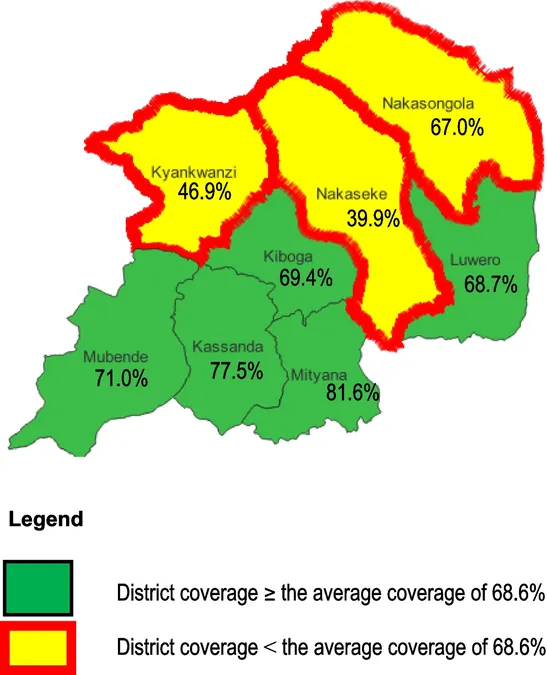
Unveiling STI Knowledge Gaps in Central Uganda: A Groundbreaking Survey
2025-05-05
Author: Arjun
A Bold Move in Public Health Assessment
This groundbreaking survey was conducted from February to March 2022 in eight districts across Central Uganda, focusing on Mubende, Kasanda, Mityana, Kiboga, Kyankwanzi, Luwero, Nakaseke, and Nakasongola. Utilizing the Lot Quality Assurance Sampling (LQAS) methodology, this approach is designed to examine the effectiveness of health programs, particularly in the realm of sexually transmitted infections (STIs) prevention and control.
Why LQAS? The Smart Choice for Effective Monitoring
For over two decades, LQAS has been a trusted methodology in evaluating various public health services, ranging from maternal health to immunization coverage. This survey aimed not just to collect data but to educate local health personnel on using LQAS, enabling immediate insights into service delivery. With LQAS, the surveys cost significantly less and can yield quick, reliable results without the need for complex statistical expertise.
Breaking Down the Survey Methodology
LQAS involves segmenting a population into manageable sub-units termed 'lots.' In this case, the eight districts were divided into 40 smaller segments, each labelled from A to AO. This granular approach enables tailored interventions for more effective public health responses. With sample sizes set to encapsulate various demographic groups, researchers conducted detailed interviews with over 3,000 participants.
Youth Awareness: A Cause for Alarm
While mothers of young children showed impressive knowledge about STIs, youth aged 15-24 years exhibited worrisome knowledge gaps. Only 44.7% of this group could identify at least two signs of STIs in women. Even more alarming, many respondents perceived themselves at low risk for contracting HIV/AIDS, raising urgent questions about awareness and behaviors.
Comparative Knowledge Across Demographics
The survey highlighted stark differences in knowledge of STI symptoms. Mothers showed the highest awareness levels, likely due to direct healthcare experiences, while young males showed concerning deficits. The low awareness among adolescents indicates an urgent need for systematic sexual health education.
A Gender Divide in Sexual Behavior and Risk
The survey revealed a concerning trend: 35.2% of men reported having multiple sexual partners in the past year, compared to only 11.0% of women. Furthermore, while 76.7% of men used condoms during high-risk encounters, only 51.4% of women did, emphasizing a critical need for gender-specific health interventions.
Encouraging Circumcision: A Double-Edged Sword
Circumcision emerged as a controversial but relevant topic. Despite findings indicating higher circumcision rates among the youth compared to national averages, the reasons for circumcision were varied, with personal hygiene and HIV risk reduction as primary motivators. Nevertheless, fear of pain and uncertainty about the benefits were significant barriers preventing uptake.
Tailoring Solutions: A Path Forward
The disparities in knowledge and attitudes around STIs call for urgent, tailored interventions. By focusing on districts with low awareness, such as Kyankwanzi and Nakaseke, and leveraging successful strategies from other areas, public health officials can craft targeted programs to reduce STI risks and improve community health outcomes.
Final Thoughts: Bridging the Gap for Better Health
The findings from this survey demonstrate a pressing need for improved communication around STI prevention and comprehensive sexual health education, particularly for youth. The time to act is now—by utilizing insights gained through this vital research, stakeholders can positively impact the health landscape of Central Uganda and beyond.



 Brasil (PT)
Brasil (PT)
 Canada (EN)
Canada (EN)
 Chile (ES)
Chile (ES)
 Česko (CS)
Česko (CS)
 대한민국 (KO)
대한민국 (KO)
 España (ES)
España (ES)
 France (FR)
France (FR)
 Hong Kong (EN)
Hong Kong (EN)
 Italia (IT)
Italia (IT)
 日本 (JA)
日本 (JA)
 Magyarország (HU)
Magyarország (HU)
 Norge (NO)
Norge (NO)
 Polska (PL)
Polska (PL)
 Schweiz (DE)
Schweiz (DE)
 Singapore (EN)
Singapore (EN)
 Sverige (SV)
Sverige (SV)
 Suomi (FI)
Suomi (FI)
 Türkiye (TR)
Türkiye (TR)
 الإمارات العربية المتحدة (AR)
الإمارات العربية المتحدة (AR)